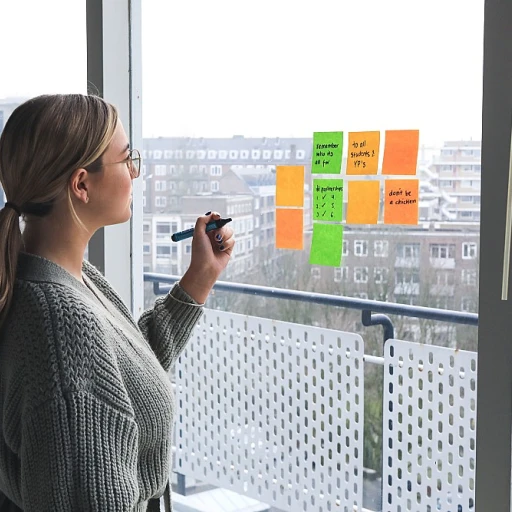
The Role of AI in Employee Feedback
The Revolution of Employee Feedback Through AI
Artificial intelligence is not just a futuristic concept, but a present-day reality that's making significant strides in the realm of human resources. One of its most transformative applications is in the field of employee feedback, where AI is revolutionizing how organizations gather, analyze, and respond to employee input. By leveraging AI in this aspect, businesses are discovering new ways to enhance communication, boost performance, and foster a more engaged workforce. AI-driven tools enable companies to analyze employee feedback more efficiently and accurately than traditional methods. Through natural language processing (NLP) and machine learning algorithms, these tools can swiftly sift through vast amounts of feedback data, identifying patterns and trends that may otherwise go unnoticed. This analytical prowess empowers organizations to respond to issues promptly and with greater precision, thus nurturing a culture of continuous improvement. Another critical advantage of AI in employee feedback is its ability to minimize biases. Traditional performance reviews and feedback mechanisms often suffer from subjective biases, which can inadvertently affect the fairness of evaluations. However, AI tools are designed to process feedback objectively, providing insights based solely on data rather than human judgment alone. This helps ensure a fairer evaluation process, promoting equal opportunities and diversity within the workplace. Furthermore, AI plays a key role in facilitating more personalized feedback experiences. By tailoring feedback to individual employees' needs and preferences, AI fosters a more meaningful dialogue between employers and employees. This personalization not only enhances the relevance of feedback but also improves employee satisfaction and motivation. With the integration of AI, organizations can transition from periodic, formal feedback sessions to a more dynamic and continuous feedback loop. This transformation heralds a shift in workplace culture, one that values open communication and ongoing development, ultimately contributing to healthier and more productive work environments. To explore more ways AI is reshaping employee feedback systems, delve into this comprehensive resource that highlights key examples and strategies.Real-Time Feedback and Its Impact
Instant Responses for Improved Communication
In the fast-paced world of modern workplaces, traditional methods of employee feedback often struggle to keep up. Enter AI, with its capability to provide real-time feedback, revolutionizing how employers and employees communicate. Leveraging AI technologies allows businesses to move beyond the standard annual performance reviews and embrace continuous, constructive conversations. Artificial intelligence facilitates instant responses, which can lead to an assortment of benefits. By quickly addressing employee concerns, misunderstandings can be cleared up before they escalate, thereby fostering a healthier work environment. This immediate feedback loop also promotes trust and transparency between employees and management, as workers feel their voices are heard and valued on a regular basis. Moreover, real-time feedback enabled by AI tools helps in identifying trends and potential issues promptly. This timely data analysis further empowers HR teams to make informed decisions and craft targeted interventions, ultimately boosting employee morale and productivity. It's also important to note the positive impact this approach has on employee learning and development. When employees receive timely input on their work performance, they can adjust their actions accordingly, which in turn accelerates their personal and professional growth. While successfully integrating AI for real-time feedback presents itself as a challenge, companies that have effectively done so are reaping the rewards. By making communication more dynamic and engaging, AI is indeed playing a crucial role in redesigning the landscape of employee feedback, as discussed further in other sections of this article.Enhancing Employee Engagement with AI
Boosting Employee Connection through Intelligent Feedback Systems
In today's rapidly evolving workplace, the need for continuous and constructive feedback has become paramount. As we delve deeper into how artificial intelligence enriches workplace dynamics, it is essential to highlight the transformative power it holds in enhancing employee engagement. AI-powered feedback systems are playing a crucial role in fostering a workplace environment where employees feel heard, motivated, and valued. One of the most significant advantages these systems offer is the personalization of feedback. Compared to traditional methods, AI can analyze vast amounts of data to provide tailored insights into an employee's performance, aligned with their personal development goals. This level of customization ensures that feedback is not only relevant but also actionable, thereby cultivating a more engaged workforce. Moreover, AI systems are adept at detecting and interpreting patterns in employee behavior and sentiment. By analyzing data from various sources such as emails, performance scores, and even social collaboration tools, AI offers a nuanced understanding of an individual's engagement level. This analysis can prompt timely interventions, support HR teams in addressing potential disengagement, and drive a culture of continuous improvement. The shift towards real-time feedback, as explored previously, aligns seamlessly with AI's capabilities to deliver immediate insights. This immediacy is crucial for managing engagement, as it allows companies to react swiftly to any concerns employees might have, thereby reducing turnover rates and increasing satisfaction. Exploring how AI tools elevate employee engagement can provide valuable insights into adopting these intelligent systems in your organization. As AI continues to develop, the focus should remain on leveraging these advancements to foster transparent communication and strong bonds between employees and their employers.AI Tools Transforming Performance Reviews
Transforming the Performance Review Process
The integration of AI in employee feedback has initiated a new era in the performance review process, making it more dynamic, data-driven, and ultimately fairer. Traditional performance reviews often suffer from biases, both conscious and unconscious, and are frequently dreaded by both employees and managers due to their infrequency and formal nature. AI tools have the potential to overhaul these systems for the better. AI systems can analyze vast amounts of employee data—both quantitative and qualitative—to provide a well-rounded picture of an employee's performance. This analysis is not limited to just annual metrics; instead, it can include ongoing inputs such as peer feedback, real-time project outcomes, and even sentiment analysis from communication tools. By doing so, AI offers a more ongoing, nuanced understanding of an employee's contributions and areas for development. Moreover, AI can help identify patterns or trends that might not be immediately visible to human reviewers. For instance, an employee consistently taking initiative in team projects could be highlighted for leadership potential, or areas where improvement is necessary could be flagged, allowing for timely interventions and support. With the help of AI, performance reviews become frequent, personalized, and focused on growth rather than judgment. Employees are thus more engaged in the process and motivated, as they see a clear path to advancement and acknowledgment of their efforts. The ability of AI to streamline and enhance performance evaluations aligns with the broader goal of improving workplace environments, as seen with AI's role in real-time feedback and engagement initiatives. As organizations increasingly adopt AI-driven performance management tools, we can anticipate a more equitable and productive workplace culture evolving in the future.AI and the Future of Employee Management
AI Revolutionizing Workforce Management
As artificial intelligence continues to infiltrate various aspects of human resources, it's impossible to ignore its transformative potential in employee management. By leveraging AI, organizations can streamline processes, optimize decision-making, and foster a culture of continuous improvement. AI's extensive capabilities don't just streamline current HR processes but promise to redefine the future of how we manage our teams. One considerable advantage of AI is its ability to provide personalized insights and data-driven recommendations for managers and HR professionals. By analyzing patterns in employee behavior, performance metrics, and feedback, AI systems can suggest tailored strategies to improve both individual and team performance. This approach ensures that management practices are aligned with the unique needs and strengths of each employee, ultimately promoting a more harmonious and productive work environment. Moreover, AI-powered systems enable predictive analytics, allowing HR leaders to anticipate workforce trends and intervene proactively. By identifying potential issues, such as waning employee engagement or looming attrition risks, organizations can take preemptive actions to maintain a thriving workplace. AI's predictive capabilities go beyond mere anticipation; they offer the insights necessary to implement strategic adjustments that avert disruption and secure organizational success. As discussed in earlier sections, the integration of AI in feedback mechanisms has already resulted in enhanced engagement and dynamic performance reviews. Moving forward, it's clear that AI will continue to expand its influence, fostering a more adaptive and resilient management structure. This evolution underscores the need for companies to remain agile and willing to embrace technological advancements in employee management practices. In sum, the future of employee management is undeniably intertwined with the growth of AI technologies. As organizations strive to build smarter, more agile teams, the role of AI in shaping these processes becomes increasingly critical. Embracing AI not only optimizes current practices but also sets the foundation for future success in managing an evolving workforce.Real-World Applications and Success Stories
Implementing AI in Real-World Scenarios
Incorporating AI into employee feedback systems has moved beyond theoretical discussions and is now making tangible impacts in various organizations. Companies across industries are leveraging AI to streamline their feedback processes, enhance accuracy, and foster a more engaged workforce.
One standout example is a multinational corporation that integrated AI-driven feedback tools to provide real-time insights to managers and employees. This approach not only improved the timeliness of feedback but also allowed for more personalized and actionable insights, aligning with the benefits discussed in earlier sections.
Another success story comes from a tech startup that used AI to transform its performance review process. By implementing AI tools, the company was able to reduce bias and focus on objective performance metrics, leading to fairer and more effective evaluations. This transformation echoes the potential of AI tools to revolutionize traditional performance reviews, as previously highlighted.
Moreover, organizations are finding that AI's ability to analyze large volumes of data quickly and accurately is invaluable in identifying trends and areas for improvement. This capability is crucial for future-proofing employee management strategies, ensuring that businesses remain agile and responsive to the evolving needs of their workforce.
These real-world applications underscore the transformative power of AI in reshaping employee feedback mechanisms, ultimately contributing to more dynamic and supportive workplace environments.









